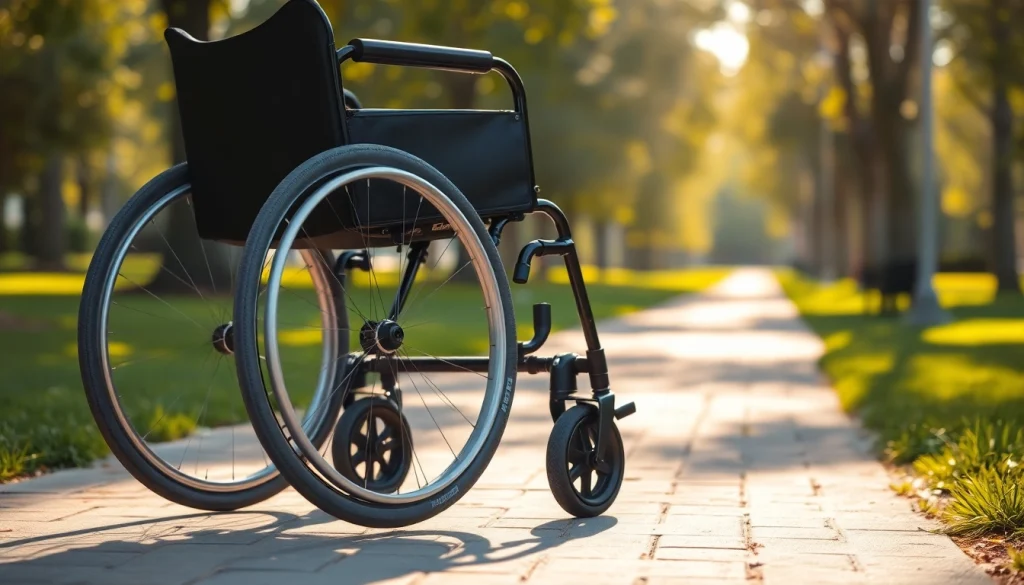Choosing the Right Manual Wheelchair: Essential Guide for Comfort and Mobility

Understanding Manual Wheelchairs
Manual wheelchairs are essential mobility solutions for individuals with limited mobility or disabilities. These lightweight, hand-propelled devices offer independence, facilitating movement while ensuring comfort and accessibility. Recognizing the variety of manual wheelchairs available can significantly enhance the quality of life for users. As you explore options, it’s crucial to understand what a manual wheelchair is, the key features and benefits, as well as the types available.
What is a Manual Wheelchair?
A manual wheelchair is a wheelchair that is powered by human effort rather than a motor. Users propel themselves forward by turning the wheels with their arms or by being pushed by a caregiver or friend. These wheelchairs vary widely in design, functionality, and weight, making them suitable for a diverse range of users with different mobility needs.
Key Features and Benefits
Manual wheelchairs come equipped with various features tailored to enhance user experience. Key benefits include:
- Independence: Many users appreciate the ability to propel their chairs, providing a sense of autonomy.
- Lightweight Design: Most manual wheelchairs are built from lightweight materials, making them easy to maneuver and transport.
- Affordability: Generally, manual wheelchairs are less expensive than their powered counterparts, making them accessible to more individuals.
- Customization Options: Many manufacturers offer customizable options to suit individual needs, including seat width, back height, and wheel size.
- Physical Health Benefits: Propelling a manual wheelchair can promote upper body strength and cardiovascular health.
Types of Manual Wheelchairs Available
There are several types of manual wheelchairs, each designed for specific needs and conditions. Here are some of the most common types:
- Standard Manual Wheelchairs: The most basic type, these are often lightweight and foldable, ideal for short-term or occasional use.
- Transport Wheelchairs: Designed for easy transport, these wheelchairs are lightweight and often come with smaller rear wheels, making them suitable for care providers to push.
- Active Wheelchairs: Designed for individuals who require more mobility and versatility, these chairs have a lower seat height and lightweight frames, allowing for easy propulsion.
- Reclining Wheelchairs: Suitable for users who may need to change their position frequently, these wheelchairs have mechanisms that allow them to recline or tilt.
- Standing Wheelchairs: These innovative designs enable users to shift into a standing position while still being seated in the wheelchair, promoting better circulation and overall health.
Selecting the Right Manual Wheelchair for Your Needs
Choosing the right manual wheelchair involves a thorough evaluation of your individual needs, preferences, and lifestyle. Factors such as mobility requirements, size, weight, and comfort features all play critical roles in the selection process. Here’s how to approach it effectively:
Consider Your Mobility Requirements
Assessing your mobility needs is the first step in selecting a suitable manual wheelchair. Consider the following:
- Daily Activities: Identify the places you often visit and the activities you engage in on a daily basis.
- Terrain: Consider if you’ll be navigating smooth surfaces, inclines, or rough terrain, as some wheels are better suited for varied environments.
- Transfer Needs: Think about how easily you can transfer into and out of the wheelchair, especially if you rely on a caregiver.
Assessing Size and Weight for Portability
The weight and dimension of a manual wheelchair are critical factors, especially regarding transport and storage. Here’s what to consider:
- Chair Weight: Lightweight models can be easily lifted into vehicles or maneuvered through narrow spaces.
- Seat Width and Depth: A proper fit is essential for comfort and support. Measure your hips and thighs to determine the right size.
- Foldability: Ensure the wheelchair can fold easily if you need to store or transport it regularly.
Evaluating Comfort Features
The comfort of a wheelchair significantly impacts the user’s daily life. When evaluating comfort, consider these features:
- Cushioning: Look for upholstery that provides adequate cushioning for extended use.
- Adjustable Armrests: Ensure that the armrests are adjustable to accommodate different user heights and preferences.
- Footrests: Footrests should be adjustable or swing-away for easy transfers and to accommodate leg length variations.
Best Practices for Maintaining Your Manual Wheelchair
Proper maintenance is essential to ensure your manual wheelchair remains in optimal condition and lasts longer. Regular upkeep will not only enhance performance but also guarantee user safety. Here are some best practices for maintaining your wheelchair:
Regular Cleaning and Upkeep
Cleaning your manual wheelchair regularly prevents dirt buildup and ensures comfort. Follow these steps:
- Wipe Down Surfaces: Use mild soap and water to clean the frame and wheels regularly.
- Inspect Upholstery: Check the chair’s fabric for tears or wear; repair or replace as necessary.
- Keep Wheels Clean: Clean the wheels to remove dirt and debris that can affect performance.
Inspecting Components for Safety
Regular inspections are crucial for the safety and functionality of your wheelchair. Consider the following:
- Check the Brakes: Ensure that wheel locks engage properly and are free from rust or debris.
- Examine Tires: Check for air pressure, tread wear, and any punctures.
- Look for Loose Parts: Regularly inspect bolts and screws to ensure everything is secure.
Adjusting Settings for Optimal Use
Tailor the wheelchair settings to meet specific requirements such as height adjustment and seating position. This can significantly enhance comfort and usability.
- Customize Seat Height: Adjust the seat height for better accessibility to tables and counters.
- Set Backrest Angle: Find a backrest angle that offers optimal support during use.
- Adjust Wheel Position: Proper wheel alignment can improve maneuverability and ease of propulsion.
Real-Life Experiences and Recommendations
Gaining insights from real-life experiences can provide valuable guidance when selecting and using manual wheelchairs. Here, we explore user stories, expert recommendations, and comparative analysis of reviews that can help prospective buyers make informed decisions.
User Stories on Choosing Manual Wheelchairs
Many users have shared their stories about choosing manual wheelchairs, highlighting factors that influenced their decisions. User testimonials often reveal:
- The importance of trialing several models before making a decision.
- How the user’s lifestyle influenced their choice, leading them to opt for an active wheelchair over a standard model.
Expert Insights on Features that Matter
Healthcare professionals and occupational therapists frequently provide invaluable advice regarding wheelchair selection. Some key insights include:
- Prioritize adjustable features for growing children or changing adult needs.
- Consider ergonomic designs that promote better posture and reduce strain on the body.
Comparing User Reviews and Ratings
Engaging with user reviews can offer additional perspective on performance and satisfaction. When reading reviews, consider:
- Overall satisfaction ratings.
- Common issues flagged by multiple users, such as durability or comfort complaints.
Innovation and Future Trends in Manual Wheelchairs
The field of manual wheelchairs is continuously evolving, with emerging technologies and trends enhancing user experience. Understanding these developments can help you stay informed about the future of mobility solutions.
Emerging Technologies Enhancing Wheelchair Design
Innovations are shaping how manual wheelchairs are designed and used. Notable advancements include:
- 3D Printing: Customizable frames created using 3D printing technology allow for personalized fits.
- Smart Features: Integration of technology such as GPS, fitness trackers, and health monitoring can provide users with critical data.
Sustainability in Wheelchair Manufacturing
The industry is increasingly adopting sustainable practices by utilizing eco-friendly materials and manufacturing processes. Sustainable options could include:
- Recyclable materials for frames and upholstery.
- Manufacturing partnerships that reduce carbon footprints.
What’s Next for Manual Wheelchair Users?
The future looks promising for manual wheelchair users. Anticipated trends may include:
- Increased customization options to adapt to diverse user needs.
- Greater emphasis on inclusivity in design, ensuring that wheelchairs cater to all body types and sizes.







